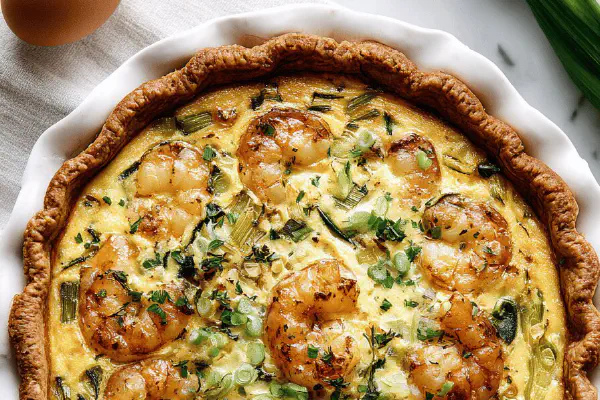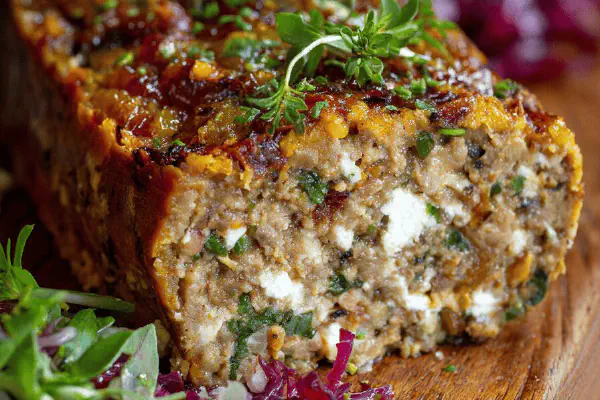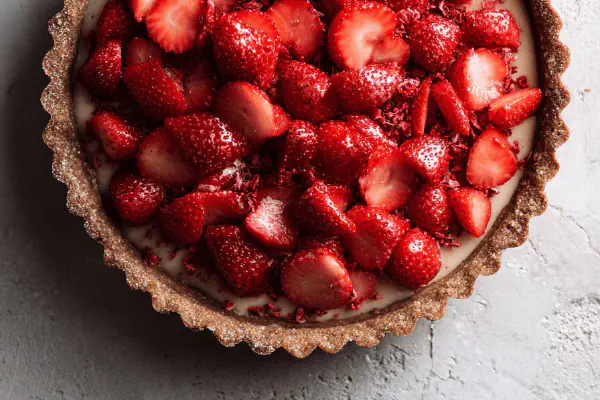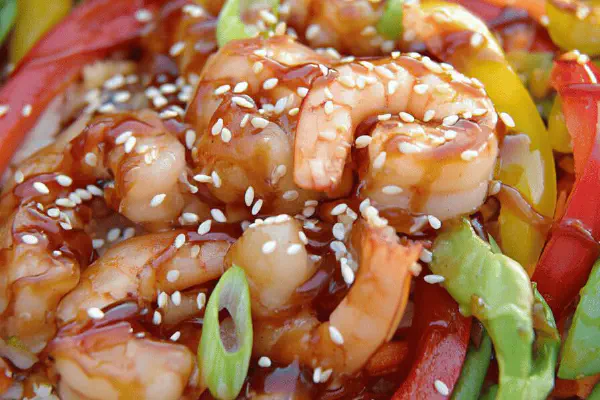Salmon Koulibiac Twist
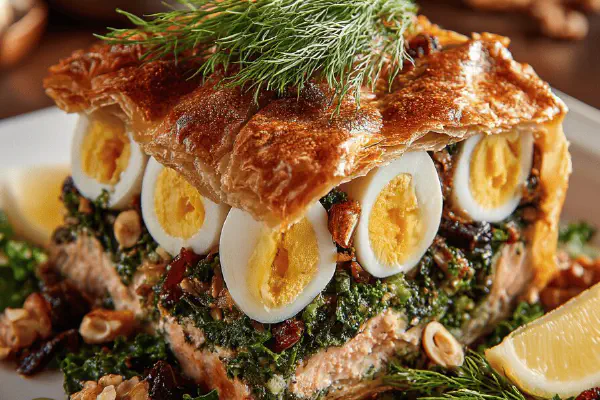
By Emma
Certified Culinary Professional
Ingredients
Dough
- 400 g (3 1/4 cups) spelt flour or all-purpose
- 3 ml (1/2 tsp) fine sea salt
- 300 g (1 1/4 cups) cold unsalted butter diced
- 40 ml (3 tbsp) extra virgin olive oil
- 45 ml (3 tbsp) icy water
- 2 large eggs beaten
Salmon
- 1 1.3 kg (about 2 3/4 lb) skinless salmon filet
- 20 ml (1 1/2 tbsp) avocado oil or olive oil
- 1 small bunch fresh dill
- 1 lemon thinly sliced
Filling
- 200 g (10 cups) baby kale leaves
- 25 g (3 tbsp) unsalted butter
- 60 g (1/3 cup) toasted hazelnuts roughly chopped
- 75 g (1/2 cup) dried tart cherries
- 8 hard-boiled eggs peeled
- 1 egg beaten for brushing
About the ingredients
Method
Dough
- Start by pulsing spelt flour, salt, and cold butter cubes in a food processor until mixture resembles coarse peas with some pea-size lumps remaining. Don’t overprocess or dough gets tough. Add olive oil and 2 eggs gradually; then drizzle icy water while pulsing between additions to bring dough together into a shaggy ball. Turn out onto floured surface; split into 2 disks, wrap tightly with plastic; chill minimum 30 min. Cold dough essential to flaky crust; butter must be cold, olive oil adds silkiness and slight chew.
Salmon preparation
- Position oven rack low, preheat oven to 210°C (410°F). Line two baking sheets with parchment paper. Place salmon filet on first sheet. Pat dry; season generously with salt and pepper. Drizzle with avocado oil for subtle buttery flavor; scatter dill sprigs and lemon slices atop. Roast roughly 7-8 minutes. The fish won’t be cooked through but infuses aromas and firms slightly—key for the wrapping phase. Remove herb and lemon debris, reserve salmon.
Filling
- In large skillet over medium-high, melt butter. Add baby kale leaves; stir until just wilted, still vibrant green. Salt and pepper. Key here: kale must be drained well to avoid soggy crust. Use fine mesh sieve, press moisture out firmly but gently. Transfer greens to bowl, fold in toasted hazelnuts and dried cherries—hazelnuts swapped for pine nuts for deeper earthiness, cherries add a lively tart pop complementing fatty salmon.
Assembly
- Flour work surface lightly. Roll both dough disks into elongated ovals roughly matching size of salmon, about 5 mm (1/4 inch) thick. Place one dough piece on second baking sheet. Center roasted salmon filet atop the dough. Pile kale mixture evenly over salmon. Now, gently but firmly line up hard-boiled eggs straight down center of fish. Fold filling sides up slightly to cradle eggs, prevents shifting.
- Brush dough edges with beaten egg; top with second dough oval. Press edges firmly to seal, trimming excess dough. Sealing is critical—no gaps or steam escapes. Cut narrow strips from dough scraps about 3 mm (1/8 inch) thick, weave lattice or design pattern atop. Brush lattice generously with egg for ultimate golden shine and crispy finish.
- Using sharp knife, make 3 small slits spaced on top crust between eggs. This lets steam out naturally. Place baking sheet in oven at 200°C (390°F). Bake 38-42 minutes. Pastry should puff slightly, turn deep amber with crackling sound when tapped lightly.
- Remove carefully; rest on rack at least 12 minutes. Resting lets interior settle—not rushing the slice. Cut thick servings ensuring slices reveal vibrant green kale, ruby cherries, golden eggs sliced perfectly in cross section.
- Hollandaise sauce optional, but recommended for brightness. Or plain lemon wedges. Holds up well served warm or room temp.
To troubleshoot
- If dough softens too much during shaping, chill again briefly. Too wet kale will leak juice—always press. Underbaking pastry yields soggy bottom; if unsure, lift corner to peek. Salmon slightly underdone is OK; residual cooking in shell. If eggs slide around, tuck kale tightly around them before sealing. Lattice adds not just beauty but venting and extra crisp.
On substitutions and tips
- Spelt flattens out more than all-purpose, adding nuttiness but slightly crumblier crust. Olive oil in dough helps pliability—extra butter can make crust greasy and heavy. Avocado oil preferred for salmon as more neutral than olive oil, but olive works. Toast hazelnuts on dry skillet until aroma releases, roughly 3-4 min stirring constantly to avoid burning. Cherry tartness can be substituted with dried cranberries or chopped dried apricots for another flavor profile.
Cooking tips
Chef's notes
- 💡 Keep butter ice cold before pulsing in processor; warm butter ruins flakiness. Watch dough texture like coarse peas, not smooth ball. Add watery ingredients gradually. Olive oil adds silkiness but limit for dough strength. Chill dough minimum 30 minutes; cold dough prevents tough crust. I saw dough turn greasy with excess butter or olive oil. Better to err on less liquid than too much.
- 💡 Kale moisture kills crust crispness. After sautéing, press firmly in fine mesh sieve using back of spoon. Must remove most water to avoid soggy bottom crust. I learned that wet kale ruins flaky layers immediately. Fold nuts and cherries only when kale is dry. Toast nuts until just aromatic, about 3-4 minutes in dry pan, stirring constantly. Raw nuts dull flavor and texture.
- 💡 Salmon quick roast at 210°C until just firm, 7-8 minutes enough. Fish continues cooking in pastry so avoid dry flakes. Removing lemon and dill sprigs before assembly stops drying. Season salmon well with salt and pepper. Avocado oil adds buttery undertones but olive oil also works. Pat salmon dry to help sealing dough later; moisture ruins crust seal.
- 💡 Roll dough a bit thicker, 5 mm or 1/4 inch, to hold fillings and eggs without collapsing. Place eggs neatly in centerline; kale folds around to stabilize. Seal edges tight with egg wash to trap steam. Cut lattice strips about 3 mm wide for venting and golden crispness. I found undersealed edges weep filling, messy and soggy bottom.
- 💡 Rest pastry minimum 12 minutes after baking; slice thick to see kale, eggs, cherries vibrant. Oven temp matters: 200°C steady bake till amber crust with slight crackling sound when tapped. Underbaked pastry is doughy bottom; check by lifting corner. Chill dough if softening during assembly. If eggs shift, tuck kale snug around before sealing.
Common questions
Why chill dough so long?
Butter needs to stay cold or crust dries greasy. Chilling firms dough for strength to hold moist filling plus hard eggs. No chill, dough softens and tears easily during roll and fold. Chill minimum 30 minutes, wrap tight to prevent drying out.
Can I use spinach instead of kale?
Spinach too watery, leaks juice. Kale sturdier. If substituting, press spinach better than usual, double pressing. Soggy filling ruins crust fast. Toast nuts same. Alternative greens need care. Watch moisture carefully whatever used.
How to prevent soggy bottom crust?
Press filling dry, especially kale—very important. Seal dough edges tight so steam escapes only at lattice or slits, not inside. Pre-cook kale briefly but no over-wilting. Baking temp and timing affect crust dryness. If crust soggy, check moisture management and doneness.
Leftovers storage?
Wrap well in foil or airtight container. Refrigerate up to 3 days. Reheat in oven not microwave for crisp crust. Can freeze unbaked pastry dough split disks wrapped tight, thaw overnight fridge. Assembled koulibiac better fresh but leftovers reheat fine with gentle oven heat.
